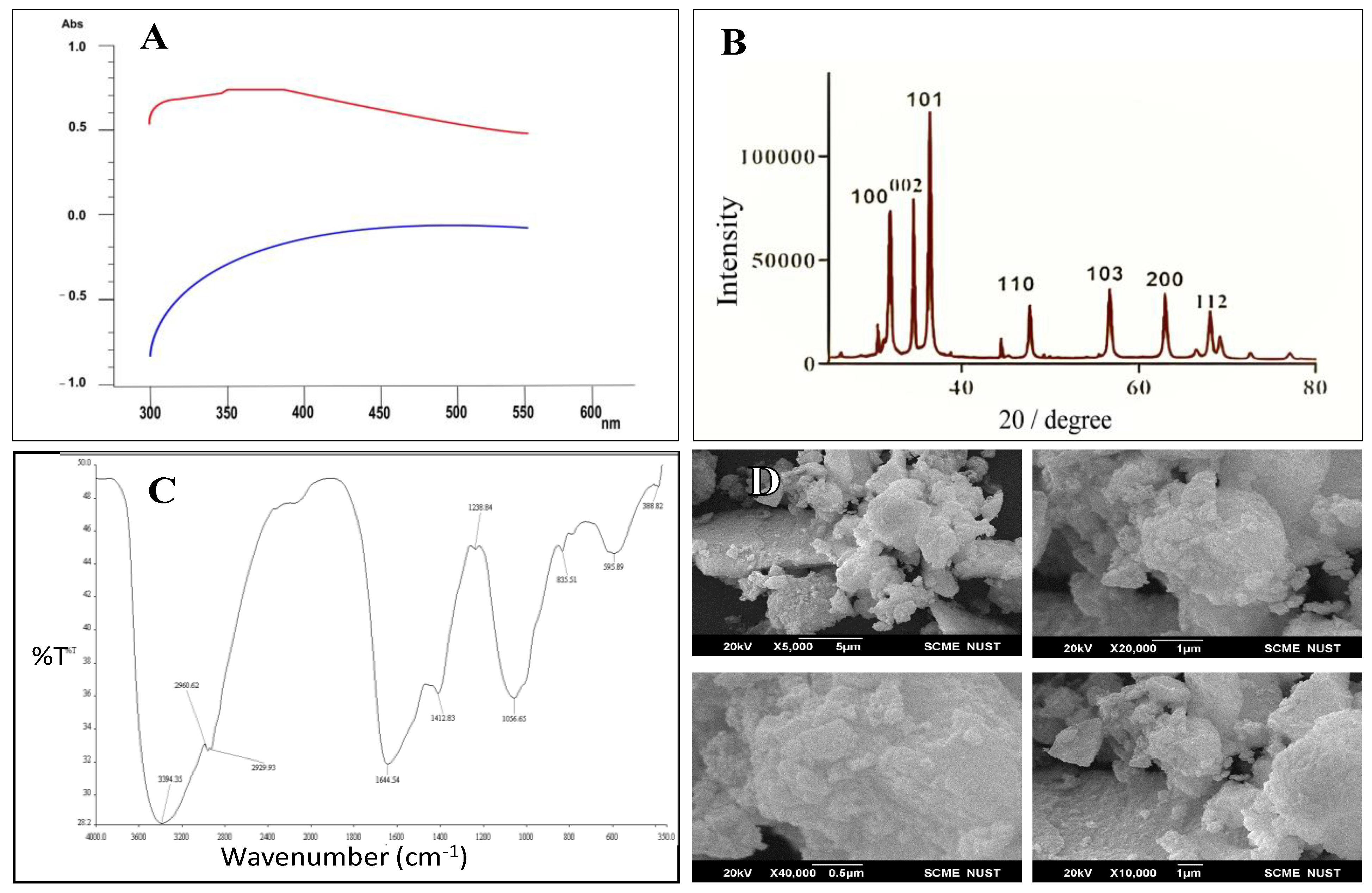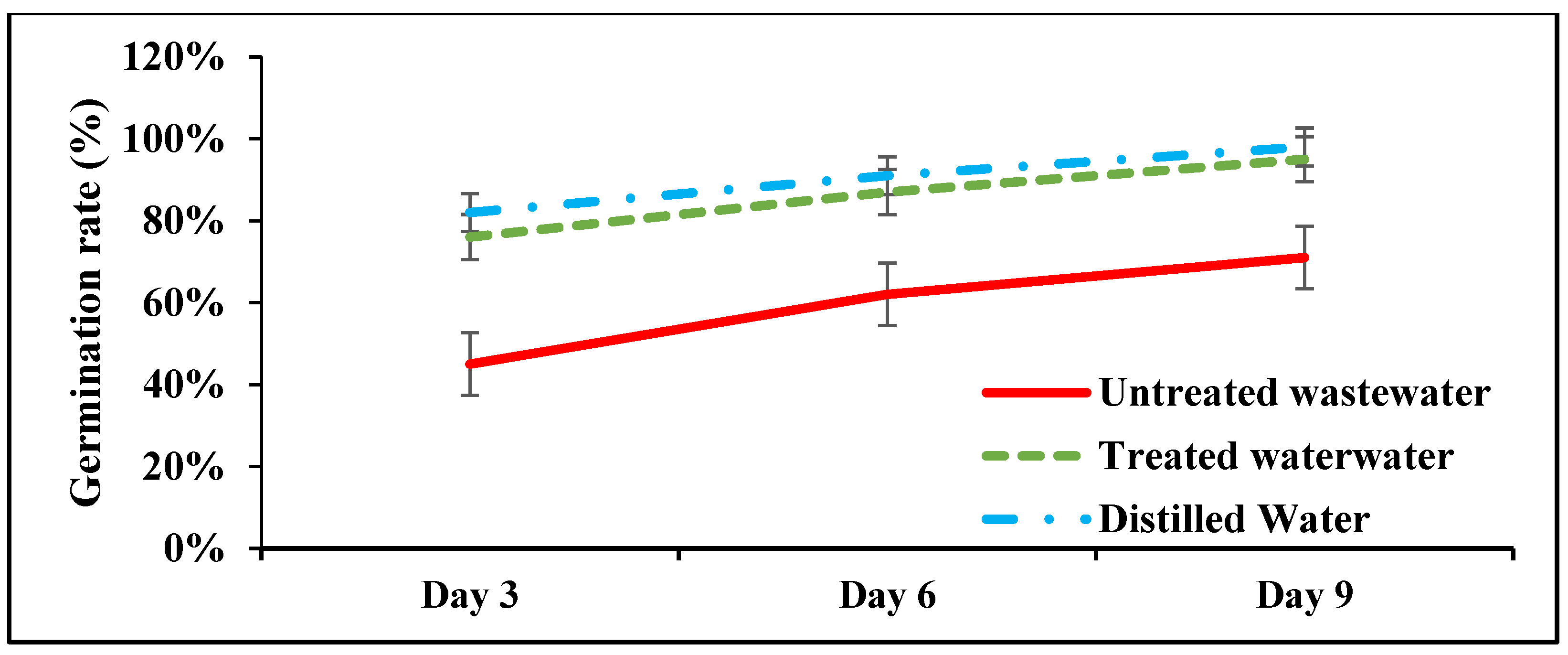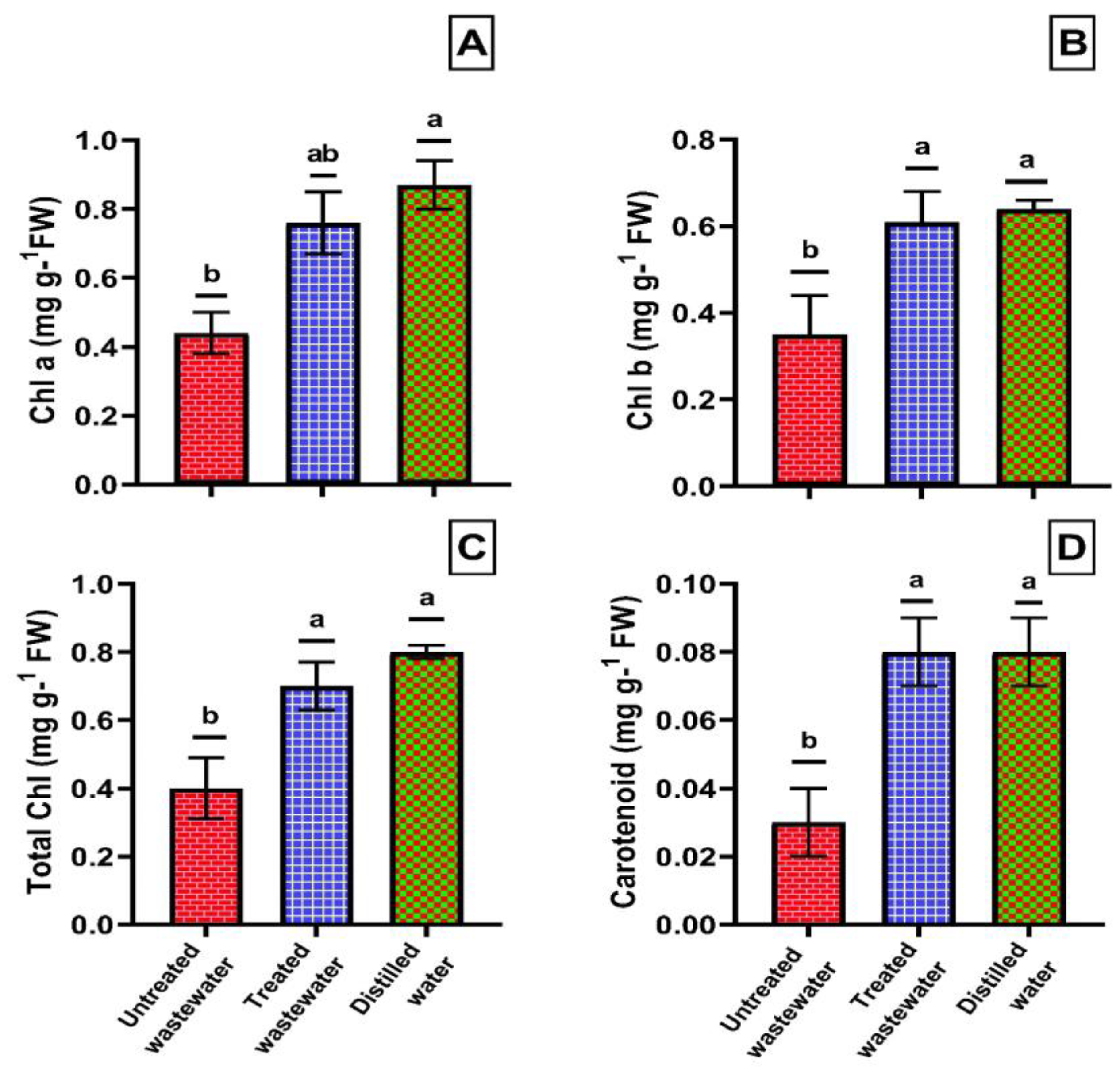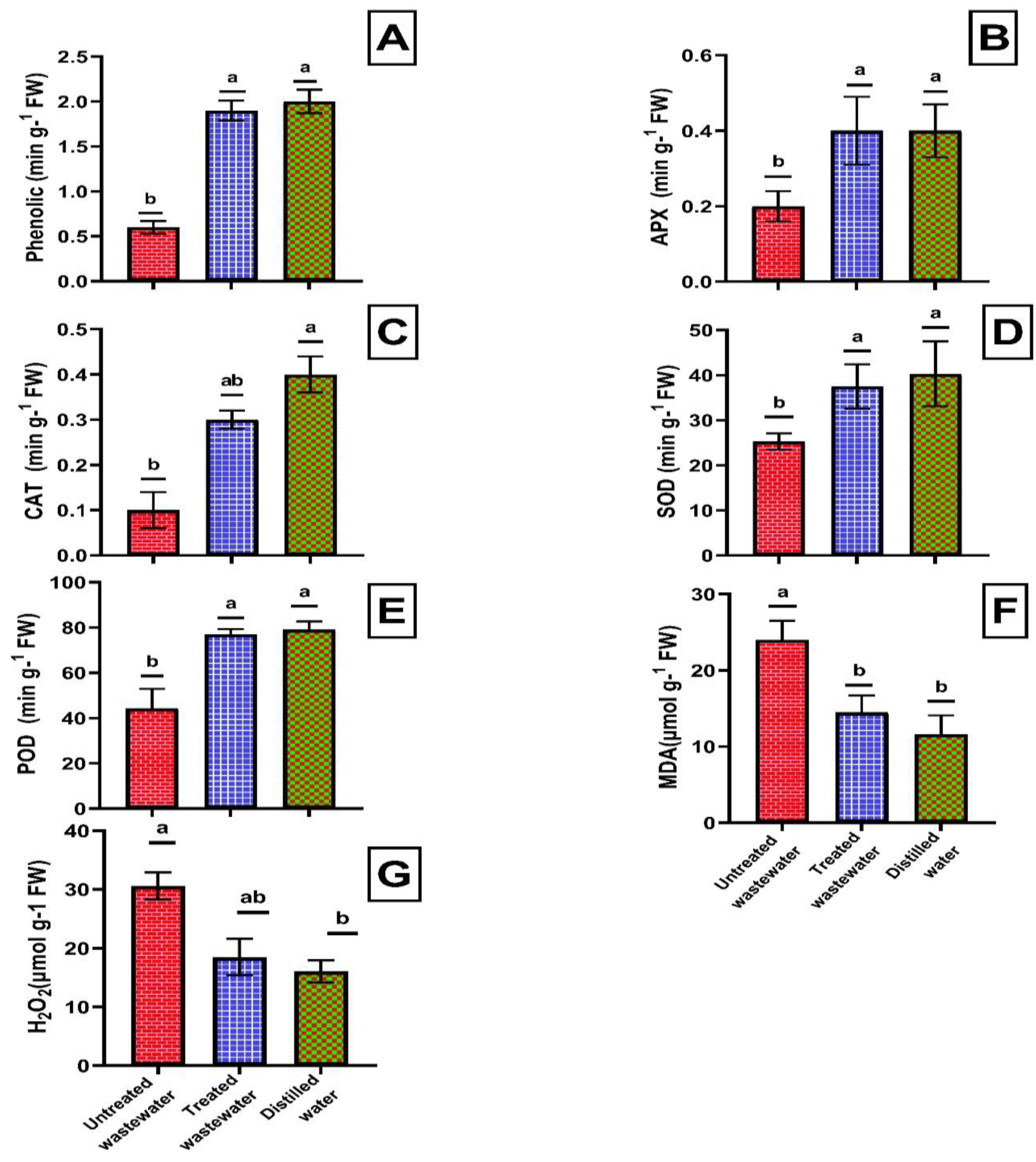Efficacy of Biogenic Zinc Oxide Nanoparticles in Treating Wastewater for Sustainable Wheat Cultivation
Abstract
:1. Introduction
2. Materials and Methods
2.1. Synthesis of Zinc Oxide Nanoparticles (ZnO-NPs)
2.2. Characterization of Zinc Oxide Nanoparticles
2.3. Application of Zinc Oxide Nanoparticles for the Treatment of Wastewater
2.4. Application of Treated Wastewater for Cultivation of Wheat Crop
Pot Experiment
2.5. Determination of Plant Morphological Parameters
2.5.1. Pigment Content Assay
2.5.2. Antioxidants
2.5.3. Oxidative Parameters
2.6. Statistical Analysis
3. Results
3.1. Characterization of Zinc Oxide Nanoparticles
3.2. Treatment of Wastewater
3.3. Physical Growth Parameters of Wheat Crop
3.4. Germination Rate
3.5. Chlorophyll Content
3.6. Activity of Oxidants and Antioxidants
4. Discussion
5. Conclusions
Author Contributions
Funding
Data Availability Statement
Acknowledgments
Conflicts of Interest
References
- D’Odorico, P.; Chiarelli, D.D.; Rosa, L.; Bini, A.; Zilberman, D.; Rulli, M.C. The Global Value of Water in Agriculture. Proc. Natl. Acad. Sci. USA 2020, 117, 21985–21993. [Google Scholar] [CrossRef] [PubMed]
- Crini, G.; Lichtfouse, E. Advantages and Disadvantages of Techniques Used for Wastewater Treatment. Environ. Chem. Lett. 2019, 17, 145–155. [Google Scholar] [CrossRef]
- Mehdi, H.; Lau, S.C.; Synyshyn, C.; Salena, M.G.; McCallum, E.S.; Muzzatti, M.N.; Bowman, J.E.; Mataya, K.; Bragg, L.M.; Servos, M.R.; et al. Municipal Wastewater as an Ecological Trap: Effects on Fish Communities across Seasons. Sci. Total Environ. 2021, 759, 143430. [Google Scholar] [CrossRef] [PubMed]
- Hossain, L.; Sarker, S.K.; Khan, M.S. Evaluation of Present and Future Wastewater Impacts of Textile Dyeing Industries in Bangladesh. Environ. Dev. 2018, 26, 23–33. [Google Scholar] [CrossRef]
- Pramanik, P.; Krishnan, P.; Maity, A.; Mridha, N.; Mukherjee, A.; Rai, V. Application of Nanotechnology in Agriculture. Environ. Nanotechnol. 2020, 4, 317–348. [Google Scholar]
- Baran, T.; Nasrollahzadeh, M. Facile Synthesis of Palladium Nanoparticles Immobilized on Magnetic Biodegradable Microcapsules Used as Effective and Recyclable Catalyst in Suzuki-Miyaura Reaction and p-Nitrophenol Reduction. Carbohydr. Polym. 2019, 222, 115029. [Google Scholar] [CrossRef]
- Ahmed, T.; Shahid, M.; Noman, M.; Niazi, M.B.K.; Mahmood, F.; Manzoor, I.; Zhang, Y.; Li, B.; Yang, Y.; Yan, C. Silver Nanoparticles Synthesized by Using Bacillus Cereus SZT1 Ameliorated the Damage of Bacterial Leaf Blight Pathogen in Rice. Pathogens 2020, 9, 160. [Google Scholar] [CrossRef]
- Ealias, A.M.; Saravanakumar, M.P. A Review on the Classification, Characterisation, Synthesis of Nanoparticles and Their Application. IOP Conf. Ser. Mater. Sci. Eng. 2017, 263, 032019. [Google Scholar] [CrossRef]
- Siddique, K.; Shahid, M.; Shahzad, T.; Mahmood, F.; Nadeem, H.; Saif ur Rehman, M.; Hussain, S.; Sadak, O.; Gunasekaran, S.; Kamal, T. Comparative Efficacy of Biogenic Zinc Oxide Nanoparticles Synthesized by Pseudochrobactrum Sp. C5 and Chemically Synthesized Zinc Oxide Nanoparticles for Catalytic Degradation of Dyes and Wastewater Treatment. Environ. Sci. Pollut. Res. 2021, 28, 28307–28318. [Google Scholar] [CrossRef]
- Mustapha, S.; Ndamitso, M.M.; Abdulkareem, A.S.; Tijani, J.O.; Shuaib, D.T.; Ajala, A.O.; Mohammed, A.K. Application of TiO2 and ZnO Nanoparticles Immobilized on Clay in Wastewater Treatment: A Review; Springer International Publishing: Cham, Switzerland, 2020; Volume 10, ISBN 0123456789. [Google Scholar]
- Maharramov, A.M.; Hasanova, U.A.; Suleymanova, I.A.; Osmanova, G.E.; Hajiyeva, N.E. The Engineered Nanoparticles in Food Chain: Potential Toxicity and Effects. SN Appl. Sci. 2019, 1, 1–25. [Google Scholar] [CrossRef]
- Mishra, S.; Keswani, C.; Abhilash, P.C.; Fraceto, L.F.; Singh, H.B. Integrated Approach of Agri-Nanotechnology: Challenges and Future Trends. Front. Plant Sci. 2017, 8, 471. [Google Scholar] [CrossRef]
- Haruna, A.; Chong, F.-K.; Ho, Y.-C.; Merican, Z.M.A. Preparation and Modification Methods of Defective Titanium Dioxide-Based Nanoparticles for Photocatalytic Wastewater Treatment—A Comprehensive Review. Environ. Sci. Pollut. Res. 2022, 29, 70706–70745. [Google Scholar] [CrossRef] [PubMed]
- Mansour, A.T.; Alprol, A.E.; Khedawy, M.; Abualnaja, K.M.; Shalaby, T.A.; Rayan, G.; Ramadan, K.M.A.; Ashour, M. Green Synthesis of Zinc Oxide Nanoparticles Using Red Seaweed for the Elimination of Organic Toxic Dye from an Aqueous Solution. Materials 2022, 15, 5169. [Google Scholar] [CrossRef] [PubMed]
- Huang, X.; Duan, S.; Wu, Q.; Yu, M.; Shabala, S. Reducing Cadmium Accumulation in Plants: Structure–Function Relations and Tissue-Specific Operation of Transporters in the Spotlight. Plants 2020, 9, 223. [Google Scholar] [CrossRef] [PubMed]
- Bundschuh, M.; Filser, J.; Lüderwald, S.; McKee, M.S.; Metreveli, G.; Schaumann, G.E.; Schulz, R.; Wagner, S. Nanoparticles in the Environment: Where Do We Come from, Where Do We Go To? Environ. Sci. Eur. 2018, 30, 6. [Google Scholar] [CrossRef] [PubMed]
- Taherizadeh, H.; Hashemifard, S.A.; Izadpanah, A.A.; Ismail, A.F. Investigation of Fouling of Surface Modified Polyvinyl Chloride Hollow Fiber Membrane Bioreactor via Zinc Oxide-Nanoparticles under Coagulant for Municipal Wastewater Treatment. J. Environ. Chem. Eng. 2021, 9, 105835. [Google Scholar] [CrossRef]
- Abbas, A.; Ahmad, T.; Hussain, S.; Noman, M.; Shahzad, T.; Iftikhar, A.; Ijaz, C.M.; Tahir, M.; Gohari, G. Immobilized Biogenic Zinc Oxide Nanoparticles as Photocatalysts for Degradation of Methylene Blue Dye and Treatment of Textile Effluents. Int. J. Environ. Sci. Technol. 2022, 19, 11333–11346. [Google Scholar] [CrossRef]
- Awasthi, G.P.; Adhikari, S.P.; Ko, S.; Kim, H.J.; Park, C.H.; Kim, C.S. Facile Synthesis of ZnO Flowers Modified Graphene like MoS2 Sheets for Enhanced Visible-Light-Driven Photocatalytic Activity and Antibacterial Properties. J. Alloys Compd. 2016, 682, 208–215. [Google Scholar] [CrossRef]
- Kumar, J.A.; Krithiga, T.; Manigandan, S.; Sathish, S.; Renita, A.A.; Prakash, P.; Prasad, B.S.N.; Kumar, T.R.P.; Rajasimman, M.; Hosseini-Bandegharaei, A. A Focus to Green Synthesis of Metal/Metal Based Oxide Nanoparticles: Various Mechanisms and Applications towards Ecological Approach. J. Clean. Prod. 2021, 324, 129198. [Google Scholar] [CrossRef]
- Ghosh, S.; Sarkar, B.; Kaushik, A.; Mostafavi, E. Nanobiotechnological Prospects of Probiotic Microflora: Synthesis, Mechanism, and Applications. Sci. Total Environ. 2022, 838, 156212. [Google Scholar] [CrossRef]
- Varshney, R.; Bhadauria, S.; Gaur, M.S.; Pasricha, R. Characterization of Copper Nanoparticles Synthesized by a Novel Microbiological Method. Jom 2010, 62, 102–104. [Google Scholar] [CrossRef]
- Griffiths, P.R. Fourier Transform Infrared Spectrometry. Science 1983, 222, 297–302. [Google Scholar] [CrossRef] [PubMed]
- Tiwari, M.; Jain, P.; Hariharapura, R.C.; Narayanan, K.; Bhat, U.; Udupa, N.; Rao, J.V. Biosynthesis of Copper Nanoparticles Using Copper-Resistant Bacillus Cereus, a Soil Isolate. Process Biochem. 2016, 51, 1348–1356. [Google Scholar] [CrossRef]
- Rice, E.W.; Bridgewater, L.; Association, A.P.H. Standard Methods for the Examination of Water and Wastewater; American Public Health Association: Washington, DC, USA, 2012; Volume 10. [Google Scholar]
- Abido, W.A.E.; Zsombik, L. Effect of Water Stress on Germination of Some Hungarian Wheat Landraces Varieties. Acta Ecol. Sin. 2018, 38, 422–428. [Google Scholar] [CrossRef]
- Akram, M.S.; Shahid, M.; Tariq, M.; Azeem, M.; Javed, M.T.; Saleem, S.; Riaz, S. Deciphering Staphylococcus Sciuri SAT-17 Mediated Anti-Oxidative Defense Mechanisms and Growth Modulations in Salt Stressed Maize (Zea mays L.). Front. Microbiol. 2016, 7, 867. [Google Scholar] [CrossRef]
- Armon, D. Copper Enzymes in Isolated Chloroplast. Plant Physiol. 1949, 24, 1–15. [Google Scholar] [CrossRef]
- Shafqat, U.; Hussain, S.; Shahzad, T.; Shahid, M.; Mahmood, F. Elucidating the Phytotoxicity Thresholds of Various Biosynthesized Nanoparticles on Physical and Biochemical Attributes of Cotton. Chem. Biol. Technol. Agric. 2023, 10, 30. [Google Scholar] [CrossRef]
- Julkunen-Tiitto, R. Phenolic Constituents in the Leaves of Northern Willows: Methods for the Analysis of Certain Phenolics. J. Agric. Food Chem. 1985, 33, 213–217. [Google Scholar] [CrossRef]
- Amako, K.; Chen, G.-X.; Asada, K. Separate Assays Specific for Ascorbate Peroxidase and Guaiacol Peroxidase and for the Chloroplastic and Cytosolic Isozymes of Ascorbate Peroxidase in Plants. Plant Cell Physiol. 1994, 35, 497–504. [Google Scholar]
- Aebi, H. [13] Catalase in Vitro. In Methods in Enzymology; Elsevier: Amsterdam, The Netherlands, 1984; Volume 105, pp. 121–126. ISBN 0076-6879. [Google Scholar]
- Chance, B.; Maehly, A.C. [136] Assay of Catalases and Peroxidases. Methods Enzymol. 1955, 2, 764–775. [Google Scholar]
- Giannopolitis, C.N.; Ries, S.K. Superoxide Dismutases: I. Occurrence in Higher Plants. Plant Physiol. 1977, 59, 309–314. [Google Scholar] [CrossRef] [PubMed]
- Heath, R.L.; Packer, L.; Heath, R.L.; Packer, L. Photoperoxidation in Isolated Chloroplasts: I. Kinetics and Stoichiometry of Fatty Acid Peroxidation. Arch. Biochem. Biophys. 1968, 125, 189–198. [Google Scholar] [CrossRef]
- Jana, S.; Choudhuri, M.A. Glycolate Metabolism of Three Submersed Aquatic Angiosperms during Ageing. Aquat. Bot. 1982, 12, 345–354. [Google Scholar] [CrossRef]
- Kookana, R.S.; Drechsel, P.; Jamwal, P.; Vanderzalm, J. Urbanisation and Emerging Economies: Issues and Potential Solutions for Water and Food Security. Sci. Total Environ. 2020, 732, 139057. [Google Scholar] [CrossRef] [PubMed]
- Pervez, M.N.; Balakrishnan, M.; Hasan, S.W.; Choo, K.-H.; Zhao, Y.; Cai, Y.; Zarra, T.; Belgiorno, V.; Naddeo, V. A Critical Review on Nanomaterials Membrane Bioreactor (NMs-MBR) for Wastewater Treatment. NPJ Clean Water 2020, 3, 43. [Google Scholar] [CrossRef]
- Mohd Yusof, H.; Mohamad, R.; Zaidan, U.H.; Abdul Rahman, N. Microbial Synthesis of Zinc Oxide Nanoparticles and Their Potential Application as an Antimicrobial Agent and a Feed Supplement in Animal Industry: A Review. J. Anim. Sci. Biotechnol. 2019, 10, 57. [Google Scholar] [CrossRef] [PubMed]
- Kaur, K.; Sidhu, A.K. Green Synthesis: An Eco-Friendly Route for the Synthesis of Iron Oxide Nanoparticles. Front. Nanotechnol. 2021, 3, 655062. [Google Scholar]
- Ehsan, M.; Waheed, A.; Ullah, A.; Kazmi, A.; Ali, A.; Raja, N.I.; Mashwani, Z.-R.; Sultana, T.; Mustafa, N.; Ikram, M. Plant-Based Bimetallic Silver-Zinc Oxide Nanoparticles: A Comprehensive Perspective of Synthesis, Biomedical Applications, and Future Trends. Biomed Res. Int. 2022, 2022, 1215183. [Google Scholar] [CrossRef]
- Abdullah, F.H.; Abu Bakar, N.H.H.; Abu Bakar, M. Low Temperature Biosynthesis of Crystalline Zinc Oxide Nanoparticles from Musa Acuminata Peel Extract for Visible-Light Degradation of Methylene Blue. Optik 2020, 206, 164279. [Google Scholar] [CrossRef]
- Jayabalan, J.; Mani, G.; Krishnan, N.; Pernabas, J.; Devadoss, J.M.; Jang, H.T. Green Biogenic Synthesis of Zinc Oxide Nanoparticles Using Pseudomonas Putida Culture and Its In Vitro Antibacterial and Anti-Biofilm Activity. Biocatal. Agric. Biotechnol. 2019, 21, 101327. [Google Scholar] [CrossRef]
- Rambabu, K.; Bharath, G.; Banat, F.; Show, P.L. Green Synthesis of Zinc Oxide Nanoparticles Using Phoenix Dactylifera Waste as Bioreductant for Effective Dye Degradation and Antibacterial Performance in Wastewater Treatment. J. Hazard. Mater. 2021, 402, 123560. [Google Scholar] [CrossRef] [PubMed]
- Ifeanyichukwu, U.L.; Fayemi, O.E.; Ateba, C.N. Green Synthesis of Zinc Oxide Nanoparticles from Pomegranate (Punica Granatum) Extracts and Characterization of Their Antibacterial Activity. Molecules 2020, 25, 4521. [Google Scholar] [CrossRef] [PubMed]
- Alikhani, M.-Y.; Lee, S.-M.; Yang, J.-K.; Shirzad-Siboni, M.; Peeri-Dogaheh, H.; Khorasani, M.-S.; Nooshak, M.-A.; Samarghandi, M.-R. Photocatalytic Removal of Escherichia Coli from Aquatic Solutions Using Synthesized ZnO Nanoparticles: A Kinetic Study. Water Sci. Technol. 2013, 67, 557–563. [Google Scholar] [CrossRef] [PubMed]
- Puay, N.Q.; Qiu, G.; Ting, Y.P. Effect of Zinc Oxide Nanoparticles on Biological Wastewater Treatment in a Sequencing Batch Reactor. J. Clean. Prod. 2015, 88, 139–145. [Google Scholar] [CrossRef]
- Soltani, S.; Gacem, A.; Choudhary, N.; Yadav, V.K.; Alsaeedi, H.; Modi, S.; Patel, A.; Khan, S.H.; Cabral-Pinto, M.M.S.; Yadav, K.K. Scallion Peel Mediated Synthesis of Zinc Oxide Nanoparticles and Their Applications as Nano Fertilizer and Photocatalyst for Removal of Organic Pollutants from Wastewater. Water 2023, 15, 1672. [Google Scholar] [CrossRef]
- Sanakousar, F.M.; Vidyasagar, C.C.; Jiménez-Pérez, V.M.; Prakash, K. Recent Progress on Visible-Light-Driven Metal and Non-Metal Doped ZnO Nanostructures for Photocatalytic Degradation of Organic Pollutants. Mater. Sci. Semicond. Process. 2022, 140, 106390. [Google Scholar] [CrossRef]
- Sikiru, S.; Ayodele, O.J.A.; Sanusi, Y.K.; Adebukola, S.Y.; Soleimani, H.; Yekeen, N.; Haslija, A.B.A. A Comprehensive Review on Nanotechnology Application in Wastewater Treatment a Case Study of Metal-Based Using Green Synthesis. J. Environ. Chem. Eng. 2022, 108065. [Google Scholar] [CrossRef]
- Batool, M.; Khurshid, S.; Qureshi, Z.; Daoush, W.M. Adsorption, Antimicrobial and Wound Healing Activities of Biosynthesised Zinc Oxide Nanoparticles. Chem. Pap. 2021, 75, 893–907. [Google Scholar] [CrossRef]
- Rahman, M.A.; Radhakrishnan, R.; Gopalakrishnan, R. Structural, Optical, Magnetic and Antibacterial Properties of Nd Doped NiO Nanoparticles Prepared by Co-Precipitation Method. J. Alloys Compd. 2018, 742, 421–429. [Google Scholar] [CrossRef]
- Dihom, H.R.; Al-Shaibani, M.M.; Mohamed, R.M.S.R.; Al-Gheethi, A.A.; Sharma, A.; Khamidun, M.H. Bin Photocatalytic Degradation of Disperse Azo Dyes in Textile Wastewater Using Green Zinc Oxide Nanoparticles Synthesized in Plant Extract: A Critical Review. J. Water Process Eng. 2022, 47, 102705. [Google Scholar] [CrossRef]
- Fouda, A.; Eid, A.M.; Abdelkareem, A.; Said, H.A.; El-Belely, E.F.; Alkhalifah, D.H.M.; Alshallash, K.S.; Hassan, S.E.D. Phyco-Synthesized Zinc Oxide Nanoparticles Using Marine Macroalgae, Ulva Fasciata Delile, Characterization, Antibacterial Activity, Photocatalysis, and Tanning Wastewater Treatment. Catalysts 2022, 12, 756. [Google Scholar] [CrossRef]
- Arabkhani, P.; Saeedi, N.; Sadeghi, H.; Nouripour-Sisakht, S.; Gharaghani, M.; Asfaram, A. Plant Extracts-Mediated Green Synthesis of Zinc Oxide/Carbon Nanofiber Nanocomposites with Highly Efficient Photocatalytic and Antimicrobial Properties for Wastewater Treatment. J. Water Process Eng. 2023, 54, 104020. [Google Scholar] [CrossRef]
- Khan, M.S.; Zaidi, A.; Wani, P.A.; Oves, M. Role of Plant Growth Promoting Rhizobacteria in the Remediation of Metal Contaminated Soils. Environ. Chem. Lett. 2009, 7, 1–19. [Google Scholar] [CrossRef]
- Dubey, R.S. Photosynthesis in Plants under Stressful Conditions. In Handbook of Photosynthesis; CRC Press: Boca Raton, FL, USA, 2018; pp. 629–649. ISBN 1315372134. [Google Scholar]
- Kanwal, A.; Farhan, M.; Sharif, F.; Hayyat, M.U.; Shahzad, L.; Ghafoor, G.Z. Effect of Industrial Wastewater on Wheat Germination, Growth, Yield, Nutrients and Bioaccumulation of Lead. Sci. Rep. 2020, 10, 11361. [Google Scholar] [CrossRef]
- Sen, S.K.; Patra, P.; Das, C.R.; Raut, S.; Raut, S. Pilot-Scale Evaluation of Bio-Decolorization and Biodegradation of Reactive Textile Wastewater: An Impact on Its Use in Irrigation of Wheat Crop. Water Resour. Ind. 2019, 21, 100106. [Google Scholar] [CrossRef]
- Albo Hay Allah, M.A.; Alshamsi, H.A. Facile Green Synthesis of ZnO/AC Nanocomposites Using Pontederia Crassipes Leaf Extract and Their Photocatalytic Properties Based on Visible Light Activation. J. Mater. Sci. Mater. Electron. 2023, 34, 1263. [Google Scholar] [CrossRef]




| Parameters | Wastewater | Treated Wastewater | NEQS Limits | % Decrease |
|---|---|---|---|---|
| pH | 8.7 ± 0.10 | 7.73 ± 0.31 | 6.5–8.5 | 11.1% |
| EC (ds m−1) | 2.39 ± 0.02 | 1.24 ± 0.10 | NG | 48.1% |
| TDS (mg/L) | 3860 ± 16 | 910 ± 12.06 | 1000 | 76.4% |
| Color intensity | 0.253 ± 0.02 | 0.09 ± 0.02 | NG | 64.4% |
| COD (mg/L) | 336.5± 7.25 | 144.43 ± 5.7 | 200 | 57% |
| Sulfates (mg/L) | 276.4 ± 6.05 | 52.4 ± 6.81 | 500 mg/L | 81% |
| Phosphates (mg/L) | 2110 ± 5.9 | 690 ± 15.1 | NG | 67.3% |
| Treatment | Shoot L (cm) | Root L (cm) | Shoot FW (g) | Root FW (g) | Shoot DW (g) | Root DW (g) |
|---|---|---|---|---|---|---|
| Untreated wastewater | 12.4 ± 1.11 b | 7.3 ± 0.90 b | 0.21 ± 0.03 e | 0.24 ± 0.12 b | 0.04 ± 0.02 b | 0.06 ± 0.03 b |
| Treated wastewater | 17.9 ± 1.74 a | 11.9 ± 2.07 a | 0.51 ± 0.07 ab | 0.45 ± 0.13 ab | 0.07 ± 0.02 a | 0.18 ± 0.06 a |
| Distilled water | 18.3 ± 1.68 a | 12.7 ± 2.29 a | 0.56 ± 0.06 a | 0.54 ± 0.13 a | 0.08 ± 0.02 a | 0.20 ± 0.08 a |
Disclaimer/Publisher’s Note: The statements, opinions and data contained in all publications are solely those of the individual author(s) and contributor(s) and not of MDPI and/or the editor(s). MDPI and/or the editor(s) disclaim responsibility for any injury to people or property resulting from any ideas, methods, instructions or products referred to in the content. |
© 2023 by the authors. Licensee MDPI, Basel, Switzerland. This article is an open access article distributed under the terms and conditions of the Creative Commons Attribution (CC BY) license (https://creativecommons.org/licenses/by/4.0/).
Share and Cite
Haidri, I.; Shahid, M.; Hussain, S.; Shahzad, T.; Mahmood, F.; Hassan, M.U.; Al-Khayri, J.M.; Aldaej, M.I.; Sattar, M.N.; Rezk, A.A.-S.; et al. Efficacy of Biogenic Zinc Oxide Nanoparticles in Treating Wastewater for Sustainable Wheat Cultivation. Plants 2023, 12, 3058. https://doi.org/10.3390/plants12173058
Haidri I, Shahid M, Hussain S, Shahzad T, Mahmood F, Hassan MU, Al-Khayri JM, Aldaej MI, Sattar MN, Rezk AA-S, et al. Efficacy of Biogenic Zinc Oxide Nanoparticles in Treating Wastewater for Sustainable Wheat Cultivation. Plants. 2023; 12(17):3058. https://doi.org/10.3390/plants12173058
Chicago/Turabian StyleHaidri, Irfan, Muhammad Shahid, Sabir Hussain, Tanvir Shahzad, Faisal Mahmood, Muhammad Umair Hassan, Jameel Mohammed Al-Khayri, Mohammed Ibrahim Aldaej, Muhammad Naeem Sattar, Adel Abdel-Sabour Rezk, and et al. 2023. "Efficacy of Biogenic Zinc Oxide Nanoparticles in Treating Wastewater for Sustainable Wheat Cultivation" Plants 12, no. 17: 3058. https://doi.org/10.3390/plants12173058
APA StyleHaidri, I., Shahid, M., Hussain, S., Shahzad, T., Mahmood, F., Hassan, M. U., Al-Khayri, J. M., Aldaej, M. I., Sattar, M. N., Rezk, A. A. -S., Almaghasla, M. I., & Shehata, W. F. (2023). Efficacy of Biogenic Zinc Oxide Nanoparticles in Treating Wastewater for Sustainable Wheat Cultivation. Plants, 12(17), 3058. https://doi.org/10.3390/plants12173058











